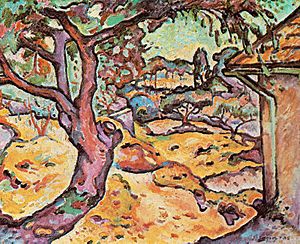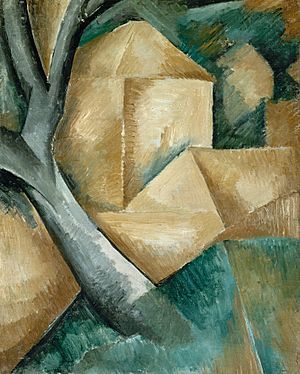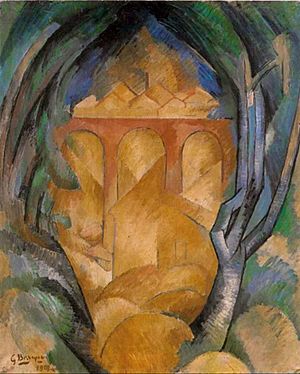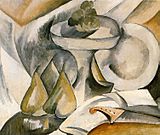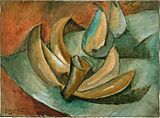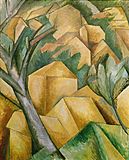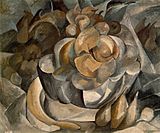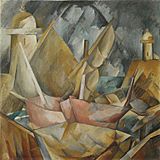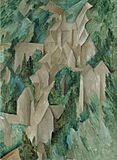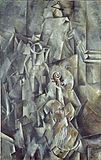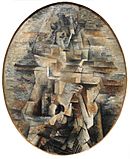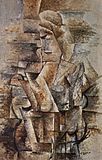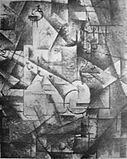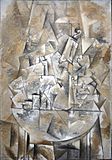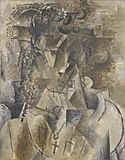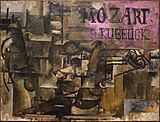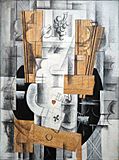Georges Braque facts for kids
Quick facts for kids
Georges Braque
|
|
|---|---|

Georges Braque, 1908, photograph published in Gelett Burgess, "The Wild Men of Paris", Architectural Record, May 1910
|
|
| Born | 13 May 1882 Argenteuil, Val-d'Oise, France
|
| Died | 31 August 1963 (aged 81) Paris, France
|
| Resting place | L'église Saint-Valery, Varengeville-sur-mer, Normandy |
| Nationality | French |
| Known for | Painting, Drawing, Sculpture, Printmaking |
| Movement | Cubism, Fauvism |
| Patron(s) | Fernand Mourlot |
Georges Braque (born May 13, 1882 – died August 31, 1963) was an important French artist in the 20th century. He was a painter, a collagist (someone who makes art by gluing different materials together), a draughtsman (someone who draws), a printmaker, and a sculptor.
Braque is best known for his part in creating two major art movements: Fauvism (starting in 1905) and Cubism. His work between 1908 and 1912 is very similar to that of his friend and fellow artist, Pablo Picasso. For many years, it was hard to tell their Cubist paintings apart. Even though Braque was a key figure, Picasso often got more attention because of his famous personality.
Contents
Early Life and Training
Georges Braque was born on May 13, 1882, in Argenteuil, France. He grew up in Le Havre. Like his father and grandfather, he first trained to be a house painter and decorator.
However, Braque also loved artistic painting. He studied art in the evenings at the École supérieure des Arts in Le Havre from about 1897 to 1899. In 1902, he moved to Paris and got a certificate as a decorator. The next year, he went to the Académie Humbert in Paris, where he painted until 1904. There, he met other artists like Marie Laurencin and Francis Picabia.
Exploring Fauvism
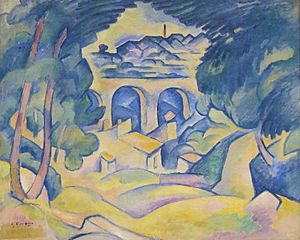
At first, Braque's paintings were in the Impressionist style. But in 1905, he saw art by a group called the "Fauves" (which means "Wild Beasts"). This group, including artists like Henri Matisse, used very bright colors to show feelings. Braque was inspired and started painting in a Fauvist style.
He worked closely with artists Raoul Dufy and Othon Friesz, who were also from Le Havre. Together, they developed a slightly calmer Fauvist style. In 1906, Braque traveled to different places like L'Estaque and Antwerp to paint.
In May 1907, Braque successfully showed his Fauvist paintings at an art show called the Salon des Indépendants. Later that year, his style began to change. He was influenced by the artist Paul Cézanne, who had recently passed away. Cézanne's works were shown in a big art show in Paris in September 1907. This show had a huge impact on many artists in Paris and helped lead to the start of Cubism.
Developing Cubism
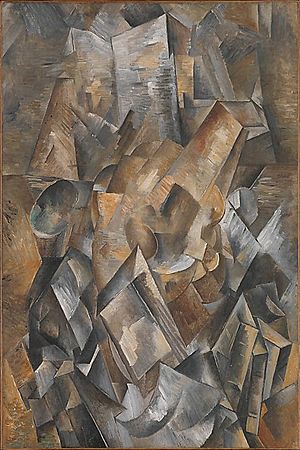
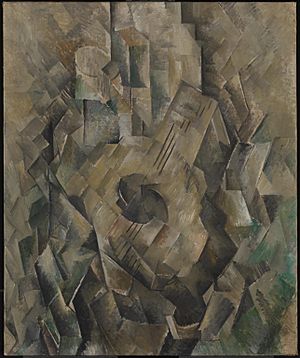
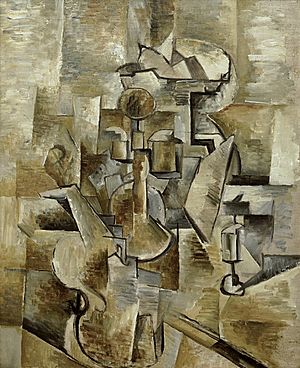
Braque's paintings from 1908 to 1912 show his new interest in shapes and seeing things from many angles at once. He studied how light and perspective worked in art. He often broke down buildings in his paintings into simple geometric shapes, like cubes. He would then shade them so they looked both flat and three-dimensional. You can see this in his painting Houses at l'Estaque.
Around 1909, Braque started working closely with Pablo Picasso. Picasso was also developing a similar style. Picasso was influenced by artists like Cézanne and by African masks. Braque was mainly interested in taking Cézanne's ideas about multiple perspectives further.
The creation of Cubism was a team effort between Braque and Picasso. They were both living in Montmartre, Paris. After meeting in late 1907, they began working together on Cubism in 1908. Both artists created paintings with limited colors and complex patterns of broken-up shapes. This style is now called Analytic Cubism.
A very important time for Cubism was in the summer of 1911. Braque and Picasso painted side by side in Céret, France. Their paintings from this time are so similar that it's often hard to tell who painted what! In 1912, they started experimenting with collage. Braque even invented a special collage technique called papier collé, which means "pasted paper."
The term 'Cubism' was first used by an art critic in 1908 to describe Braque's work. He said Braque was "reducing everything... to geometric schemas, to cubes." The name stuck, even though Picasso and Braque didn't use it themselves at first.
Braque and Picasso's strong partnership continued until World War I began in 1914. Braque joined the French Army. In May 1915, he was badly injured in the head during battle and temporarily lost his sight. He needed a long time to recover.
Later Work and Style
Braque started painting again in late 1916. Working alone, he made Cubism a bit softer. His new style used brighter colors and textured surfaces. After moving to the Normandy coast, he also started including human figures in his art again. He painted many still lifes, always focusing on how things were put together. An example is his 1943 painting Blue Guitar. During his recovery, he became good friends with another Cubist artist, Juan Gris.
Braque continued to create art for the rest of his life. He made many paintings, prints, and sculptures. He also helped introduce Picasso to Fernand Mourlot, a famous printmaker. Braque himself made many lithographs (a type of print) and book illustrations in the 1940s and 1950s. In 1952–53, he painted The Birds on the ceiling of a room in the Louvre Museum.
Georges Braque passed away on August 31, 1963, in Paris. He is buried in the cemetery of the Church of St. Valery in Varengeville-sur-Mer, France, where he also designed the church windows. Braque's art can be found in major museums all over the world.
Braque's Artistic Style
Braque believed that artists experienced beauty through "volume, line, mass, [and] weight." He felt that breaking objects into fragments helped him show space and movement in his paintings. He often used a limited, neutral color palette because he thought it would make the main subject stand out more.
While Braque started by painting landscapes, he and Picasso discovered the benefits of painting still lifes around 1908. Braque explained that he liked still lifes because they allowed him to "touch things and not merely see them." He felt that in a still life, you could feel the distance to an object, while in a landscape, you mostly saw the distance between things. Still lifes also made it easier to show an object from many different angles at once.
After the World Wars, Braque's Cubist style became more free and relaxed. He used more intense colors and painted objects with looser lines. However, he still used the Cubist idea of showing things from many angles and breaking them into pieces. Unlike Picasso, who constantly changed his style, Braque mostly stuck to Cubism. He created glowing, dream-like still lifes and figures. By the time he died in 1963, he was seen as one of the most important figures in modern art.
2010 Art Theft
On May 20, 2010, the Musée d'Art Moderne de la Ville de Paris reported a major art theft. Five paintings were stolen overnight from their collection. One of them was L'Olivier Près de l'Estaque (Olive Tree near Estaque) by Georges Braque. The other stolen paintings were by Pablo Picasso, Henri Matisse, Amedeo Modigliani, and Fernand Léger. The total value of the stolen art was estimated at €100 million (about $123 million USD).
A window had been broken, and security cameras showed a masked person taking the paintings. Authorities believe the thief acted alone. The person carefully took the paintings out of their frames and left the empty frames behind.
Gallery
-
Georges Braque, 1911, Nature morte (Still Life), Reproduced in Du "Cubisme", by Albert Gleizes and Jean Metzinger, 1912
See also
 In Spanish: Georges Braque para niños
In Spanish: Georges Braque para niños
- Crystal Cubism


